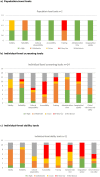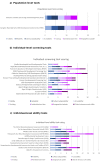Rating early child development outcome measurement tools for routine health programme use
- PMID: 30885963
- PMCID: PMC6557219
- DOI: 10.1136/archdischild-2018-315431
Rating early child development outcome measurement tools for routine health programme use
Erratum in
-
Correction: Rating early child development outcome measurement tools for routine health programme use.Arch Dis Child. 2020 Feb;105(2):e3. doi: 10.1136/archdischild-2018-315431corr1. Epub 2019 Dec 5. Arch Dis Child. 2020. PMID: 31806617 Free PMC article. No abstract available.
Abstract
Background: Identification of children at risk of developmental delay and/or impairment requires valid measurement of early child development (ECD). We systematically assess ECD measurement tools for accuracy and feasibility for use in routine services in low-income and middle-income countries (LMIC).
Methods: Building on World Bank and peer-reviewed literature reviews, we identified available ECD measurement tools for children aged 0-3 years used in ≥1 LMIC and matrixed these according to when (child age) and what (ECD domains) they measure at population or individual level. Tools measuring <2 years and covering ≥3 developmental domains, including cognition, were rated for accuracy and feasibility criteria using a rating approach derived from Grading of Recommendations, Assessment, Development and Evaluations.
Results: 61 tools were initially identified, 8% (n=5) population-level and 92% (n=56) individual-level screening or ability tests. Of these, 27 tools covering ≥3 domains beginning <2 years of age were selected for rating accuracy and feasibility. Recently developed population-level tools (n=2) rated highly overall, particularly in reliability, cultural adaptability, administration time and geographical uptake. Individual-level tool (n=25) ratings were variable, generally highest for reliability and lowest for accessibility, training, clinical relevance and geographical uptake.
Conclusions and implications: Although multiple measurement tools exist, few are designed for multidomain ECD measurement in young children, especially in LMIC. No available tools rated strongly across all accuracy and feasibility criteria with accessibility, training requirements, clinical relevance and geographical uptake being poor for most tools. Further research is recommended to explore this gap in fit-for-purpose tools to monitor ECD in routine LMIC health services.
Keywords: early child development tools; health systems; low and middle income countries; maternal, newborn and child health; metrics.
© Author(s) (or their employer(s)) 2019. Re-use permitted under CC BY-NC. No commercial re-use. See rights and permissions. Published by BMJ.
Conflict of interest statement
Competing interests: The following authors on this paper have intellectual inputs and leadership roles for some of the tools reviewed: MDAT (JC), IYCD (VC, TD) and CREDI (DCM and GF). None of these authors rated any of these tools.
Figures






References
-
- United Nations. Sustainable Development Goals, 2015.
-
- Every Woman Every Child. The Global Strategy for Women’s, Children’s and Adolescents’ Health (2016–2030), 2015.
-
- World Health Organisation. Nurturing Care Framework. Geneva: World Health Organisation, 2018. https://www.who.int/maternal_child_adolescent/documents/nurturing-care-e...
Publication types
MeSH terms
Grants and funding
LinkOut - more resources
Full Text Sources
Medical
Miscellaneous
